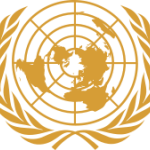- Sektör: NGO
- Number of terms: 31364
- Number of blossaries: 0
- Company Profile:
The United Nations Organization (UNO), or simply United Nations (UN), is an international organization whose stated aims are facilitating cooperation in international law, international security, economic development, social progress, human rights, and the achieving of world peace.
Addition of air to water resulting in a rise of its dissolved oxygen level. Specifically, aeration is applied in waste water treatment. In that case, aeration is used to maintain an appropriate oxygen concentration in the waste water in order to promote biological oxidation and to keep the activated sludge in suspension.
Industry:Environment
Oil, discharged accidentally or intentionally, that floats on the surface of water bodies as a discrete mass and is carried by the wind, currents and tides. Oil spills can be partially controlled by chemical dispersion, combustion, mechanical containment and adsorption. They have destructive effects on coastal ecosystems.
Industry:Environment
Share of the Total Allowable Catch (TAC) allocated to an operating unit such as a country, a vessel, a company or an individual fisherman (individual quota). Quotas may or may not be transferable, inheritable, and tradable. While generally used to allocate TAC, quotas could be used also to allocate fishing effort or biomass.
Industry:Environment
A state of complete physical, mental and social well-being and not merely the absence of disease or infirmity, as defined by the World Health Organization (WHO). Methodology to assess health according to the above definition is not yet available, and at present health is generally assessed in terms of mortality and morbidity.
Industry:Environment
Synthetic organic chemical of the chlorinated hydrocarbon class. It is one of the most toxic compounds known to humans whose harmful effects, even in extremely minute concentrations, include induction of cancer and birth defects. It has become a widespread pollutant because of the use of certain dioxin- containing herbicides.
Industry:Environment
Condition of the atmosphere at a particular location (microclimate) or region over a long period of time. It is the long-term summation of atmospheric elements - such as solar radiation, temperature, humidity, precipitation type (frequency and amount), atmospheric pressure and wind (speed and direction) - and their variations.
Industry:Environment
Maximum amount of waste materials that can be treated during one year according to usual standards and technology in a particular treatment plant or installation. Capacity can be expressed in terms of the daily volume of waste water treated, the population equivalent (for waste-water treatment) or the weight that can be treated.
Industry:Environment
Living resources in the community or population from which catches are taken in a fishery. Use of the term fish stock usually implies that the particular population is more or less isolated from other stocks of the same species and hence self-sustained. In a particular fishery, the fish stock may be one or several species of fish.
Industry:Environment
Method for estimating the size of animal populations that involves an observer's moving along a straight line through a study area and noting the distance from the line of all animals seen. It could also be used in principle with plants, although in practice alternative sampling schemes have been found to be more convenient.
Industry:Environment
Parameter, or a value derived from parameters, that points to, provides information about and/or describes the state of the environment, and has a significance extending beyond that directly associated with any given parametric value. The term may encompass indicators of environmental pressures, conditions and responses (OECD, 1994).
Industry:Environment
